Keep your cool: External shading buyers guide
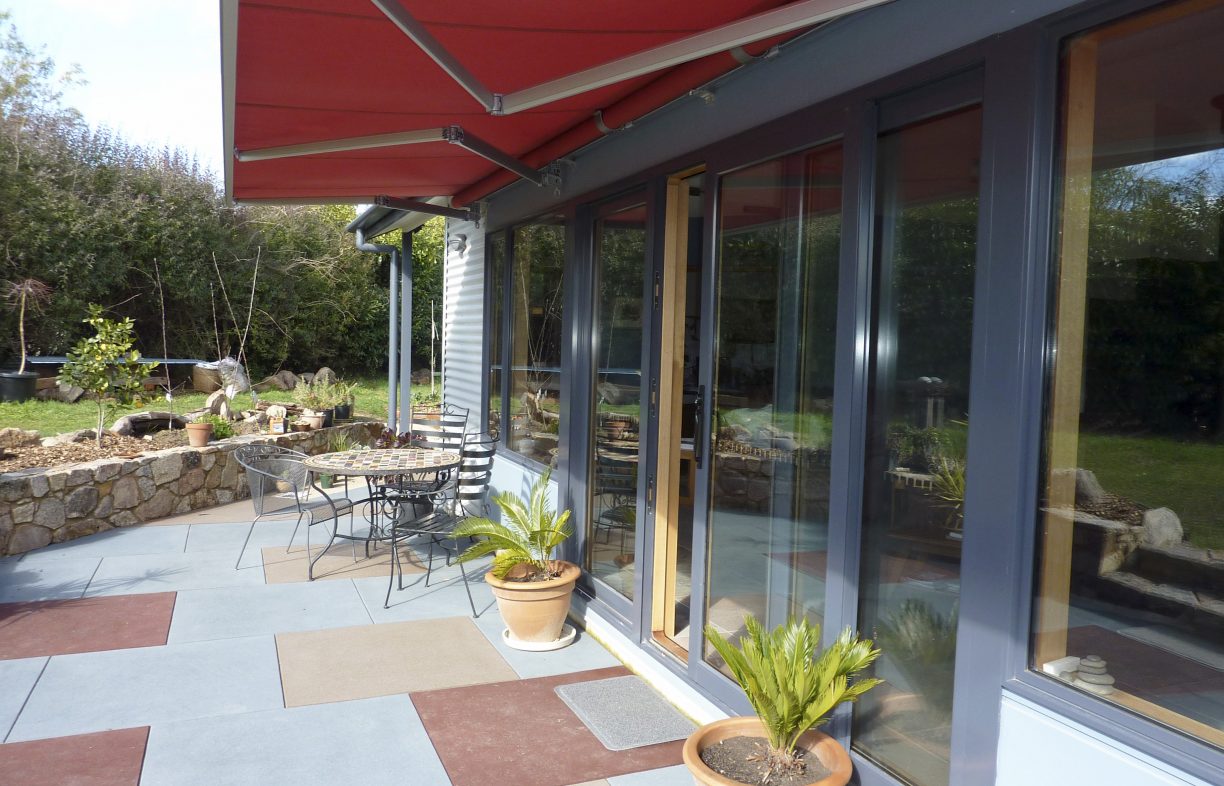
With summers getting hotter in many parts of Australia, keeping the sun off your windows and out of your home is becoming even more important. Anna Cumming looks at the options for external shading, for both new builds and retrofits.
This article was first published in Issue 138 (Jan-Mar 2017) of Renew magazine.
There’s been quite a shift from pre-industrial times when glass was an artisan-crafted luxury item, and homeowners were taxed according to the number of panes they had. These days, our houses are getting bigger and so are our windows—often to the point of comprising entire walls. Windows and glazed doors frame views, admit natural light and breezes, and allow a connection with the outdoors. In a well-designed house, they also admit the sun’s warmth in winter to assist passive thermal performance.
However, from a thermal efficiency point of view, windows are the weak link in a home’s building envelope: Your Home notes that up to 40% of a home’s heating energy can be lost and up to 87% of its heat gained through windows. Efficient double-glazed windows with thermally broken frames (preventing heat conduction through the frame) perform considerably better—advanced glazing solutions can exclude up to 60% of heat compared to plain single glazing—but will still allow more heat to enter in summer and escape in winter than the adjacent wall.Internal thermal blinds or curtains can help a lot in preventing heat loss through windows in winter, but to tackle unwanted radiant heat gain in the hotter months, it’s far more efficient to stop the sun hitting the glass in the first place with appropriate external shading.
Location and orientation
There is a huge variety of options for keeping the sun at bay, from carefully chosen deciduous plantings and simple solutions like a piece of shadecloth on a frame, to awnings, shutters, blinds, and even pergolas with sensor-operated louvre roofs. To choose the best solution, firstly it’s important to consider your location and the orientation of your windows.
In most of Australia, shading is needed on windows on the north, and also the east (to prevent summer sun heating the house from early in the morning) and west (to block hot late afternoon sun). North of the Tropic of Capricorn, thought should also be given to shading windows on the south side of your house, as the sun’s steeply angled path in summer means these windows will also receive direct sun. Helpfully, the Geoscience Australia website allows you to find your latitude and calculate the sun angle at any time of the day, on any day of the year.
Even at the same latitude, different local climates will mean different shading priorities. Perth-based architect Sid Thoo points out the importance of protecting east and west windows in his part of the country: “Summer morning and afternoon sun can be very harsh in WA.” However, a house at a similar latitude in alpine NSW might instead prioritise maximising solar gain for winter.
Because of the angle of the sun through the day, one size does not fit all when it comes to shading for all of the windows in your house. For windows within 20°W and 30°E of solar north, it’s easy to exclude summer and admit winter sun using simple horizontal devices, including eaves and awnings. This also applies to south-facing windows in the tropics. It’s reasonably straightforward to calculate the optimal width and height of eave that will stop the higher angle summer sun from hitting the window and yet allow welcome lower angle winter sun to penetrate deeply inside the room; Your Home provides a rule of thumb.
For east and west windows, however, a different approach is needed as the low-angle morning and afternoon summer sun from these directions is more difficult to block. Angled or vertical shading is most effective here, and often an adjustable solution is best so it can be deployed only when needed.
Shading options
External shading products and structures fall into two broad categories: fixed and adjustable. Fixed solutions have the advantage of simplicity, and with no moving parts, are usually easier to maintain and last longer. However, they need to be carefully designed to avoid compromising solar access in winter. In addition, in southern Australia there is a month or so in late summer when temperatures are still high but the angle of the sun is low enough to peep under even optimally sized fixed eaves, and another period in late winter when the sun’s warmth is still desired but is already being blocked.
Adjustable shading allows a house’s occupants much more control over how much direct sun to admit. Such systems can be manually operated or motorised; fitted with sensors to allow them to respond automatically to sun, rain and wind conditions; and even integrated with comprehensive smart home automation systems.
An energy rating scheme for window coverings, WincovER, has recently been developed by the Blind Manufacturers’ Association of Australia (BMAA)—see box at the end of this article for more information.
Fixed shading
Eaves and overhangs: If you’re at the design stage for a new house or a major extension, don’t miss the opportunity to think about fixed shading as part of the design. Sid Thoo points out that including simple and appropriately sized eaves or second-storey overhangs is a very straightforward, cost-effective solution. “External shading can also form part of the design aesthetic,” he says.
Shaila Divakarla, architect and Standards & Technical Manager at Good Environmental Choice Australia (GECA), agrees. “If you’re clever, you’ll integrate it as part of the design. Many things can be done that provide shading and also enhance the aesthetics of the house, or fulfil another function at the same time: a porch that also gives shelter from rain, or a pergola that also provides extra outdoor living space. This is a better use of resources and money.”
As eaves and overhangs are essentially part of the house or extension, they are usually made from the same materials as the structure, requiring negligible extra investment.
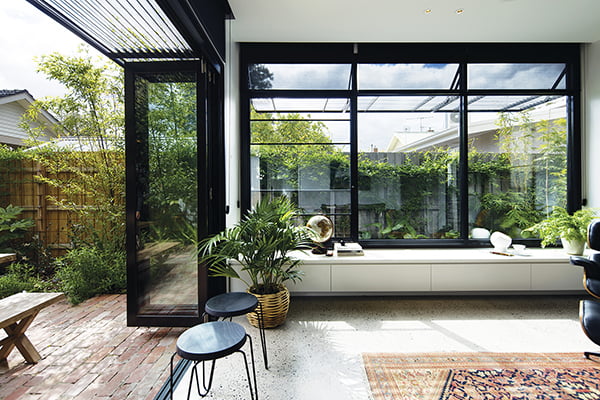
Fixed awnings: If you don’t have the luxury of designing from scratch and including eaves, an option for shading north windows (and south windows in the tropics) is a fixed horizontal or angled awning. These can be made from a wide variety of materials including steel, timber, corrugated sheet metal, cement sheet and rigid polycarbonate sheet. They should extend past the sides of the window to keep the sun off the glass for longer.
Fixed louvres/blades on window: Usually made from metal or timber, louvres or blades are fixed in a frame or rack against the window and can be placed running horizontally or vertically. They are particularly useful where privacy is needed or to comply with overlooking regulations.
Pergola with fixed angled blades: Pergolas are an enduringly popular feature in Australian gardens, but striking the balance between having a great shady outdoor living space when it’s hot, and still letting sunlight and warmth into your house when it’s not, can be tricky. Roofing your pergola with fixed blades set at an angle designed to optimise winter sun access is one option; others include translucent but thermally effective polycarbonate sheet roofing (see box for case study on Shaila’s pergola), and simply growing a deciduous vine over it.
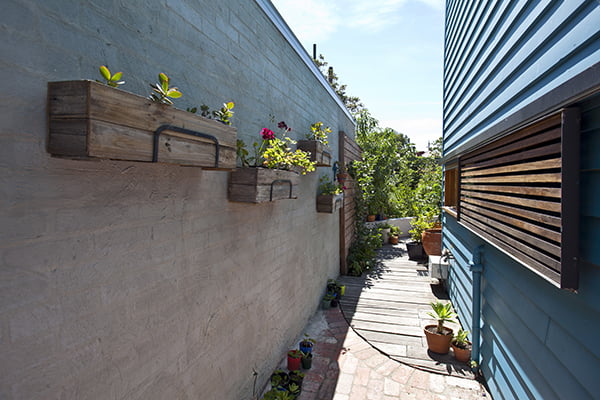

Shade sails and umbrellas: Made from knitted polyethylene fabric that’s available in a range of different light blockout levels (there will often be separate, and usually different, visible light and UV blockout ratings), shade sails can be bought off the shelf or custom designed for specific spaces—or even made at home. They are reasonably easy to install yourself, although they require firm fixings. If some rain protection is required, sails and umbrellas also come in waterproof coated fabric.
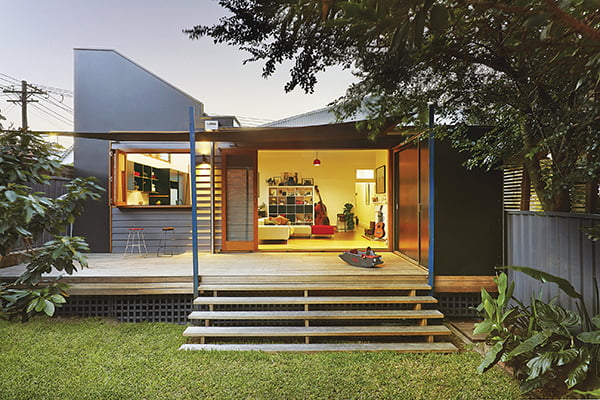
Adjustable shading
Retractable awnings and blinds: Pivot arm, folding arm, horizontal awnings on wires, roller, vertical drop—retractable awnings and blinds come in many styles. They can be closed up when not needed, allowing full winter sun access. With no support poles or attachments when extended, folding arm awnings in particular are quite susceptible to wind damage, but they can be fitted with sensors that close them automatically when bad weather hits.
“The development in awning technology recently has been huge,” says Joe Turner, president of the BMAA. “One of most popular new styles is the stainless wire guide awning; it’s a vertical drop awning that runs down fixed wires and locks in at the bottom. The system keeps the blind really taut.”
Adjustable louvres/blades on window: They are a pricier option, but metal louvres reflect more heat than fabric shading options, and adjustable versions offer scope for fine-tuning light levels inside the room. “Our external venetian blinds bounce the light into the room, giving soft diffuse light without the heat,” explains Bryce Hedditch, from blind and shutter supplier Sonnenschutz. This style of shading is also good for privacy without sacrificing too much daylight.
Pergola/solar roof with adjustable blades: Another big ticket item, pergolas with adjustable blade roofs such as those offered by Vergola can be completely rainproof when closed, turning your outdoor living area into an all-weather space.
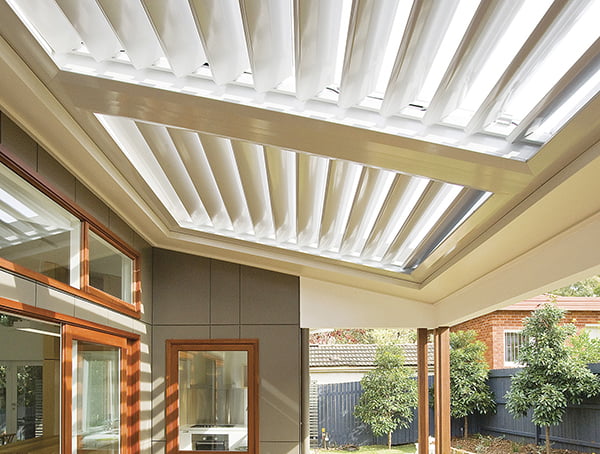
Shutters and screens: External shutters and screens—hinged, bifold, sliding or roller—are usually made from Thermalite (a high density plastic foam), timber or aluminium, and sometimes steel. As they are fitted very close to the window, “they stand up to all sorts of weather,” says Joe Turner. Depending on the material and style chosen, they can also perform insect screening, security and bushfire ember protection functions.
Deciduous plants
Don’t overlook the option of using deciduous plants to provide shade to your house. Depending on the space available, this could be a vine growing on a freestanding frame or pergola, or a tree planted to block western summer sun. Be careful to match plant characteristics (such as foliage density, canopy height and spread) to your shading requirements, and choose local native species with low water requirements where possible. Plants can also be used to shade your walls: see ‘Green facades’ in Sanctuary 37 for more.
Materials
Many different materials can be pressed into service as external shading, depending on the application and desired characteristics. Rigid materials include timber (for pergolas, fixed awnings, shutters), aluminium and steel (fixed and adjustable louvres, fixed awnings, shutters, screens), polycarbonate sheet (pergola roofs, fixed awnings), and even concrete (for formed window surrounds).
For flexible shading (blinds, adjustable awnings), traditional canvas is still available but it’s been joined by more high-tech PVC, polyester and even fibreglass fabrics. “I’d rate these newer sun screen fabrics very highly,” says Joe Turner. “They incorporate small holes that let light in and views, they breathe, and they have a better shading effect than canvas.” According to Joe, while cotton canvas is made here, no acrylic shading fabrics are made in Australia; they are all imported from Europe (mainly Spain), China and the USA, meaning that the sea miles to get them here needs to be taken into consideration in any life cycle analysis.
As always, making an environmentally responsible choice is a matter of considering many factors including renewability of raw materials, the manufacturing process, recyclability, durability and expected lifespan, maintenance requirements and end-of-life disposal. Shaila Divakarla sums it up: “There are plenty of choices available at the moment. Every material has some advantages and disadvantages, so requires careful consideration of your particular needs and location. Think of the life cycle—where is the material coming from? Does it have any toxic components? How much energy does it take to make it? What happens at the end of its life?”
As external shading products are exposed to harsh environmental conditions, natural materials are often not suitable or would have a greatly reduced lifespan. Sid Thoo explains his approach: “Durability can be an issue—I try to avoid things with moving parts, or that will require sealing or repainting over time. They might look great when first installed, but if they are then hard to access or maintain, this can become an issue over the life of the building.”
Bryce Hedditch also advocates looking for durability. While the manufacture of the aluminium for Sonnenschutz’s external venetian blinds is energy intensive, “they will last for 25 to 30 years and can then be restrung, and keep going.” Aluminium is also easy to recycle when the blinds eventually reach the end of their useful life.
“Think about it as a system,” suggests Shaila. “For example, timber is renewable, but think about the finishes you’ll need to protect it and extend its lifespan in an external shading context. Are the finishes eco friendly? What maintenance will be needed?”
Unfortunately, GECA does not yet have a standard and certification process for shading products, but Shaila says it’s on their wishlist. GECA is part of a 25-member international community, and Shaila’s team is looking at fast tracking and adapting an existing standard for Australian use.
Other considerations
Along with shading type, choice of material, and whether fixed or adjustable is best, there are many other factors to consider before selecting your external shading.
Space: The optimal shading solution for a given window just might not fit in the space available, especially if the window is built very close to a boundary. Perhaps consider a combination of a different external shade and an internal blind instead.
Visibility and permeability: Older-style canvas blinds and awnings are effective shading, but also cut off views to outside, block breezes and dramatically reduce daylight. Louvres, perforated screens and shutters, and blinds and awnings made from more modern high-tech mesh fabrics, allow airflow and diffuse daylight through while still blocking a significant proportion of direct solar heat gain.
Ease of operation: Consider how your windows open: will your external shading get in the way? Install vertically-hung or angled shading far enough away from casement windows to allow them to open. Can manually-operated shading be reached easily from inside by opening the window, or will it require a trip outside? Is it easy to operate by yourself? If your shading is tricky to operate, it’s likely it won’t be used optimally to regulate solar access, reducing its energy efficiency contribution.
Mechanisation: For shading on hard-to-access windows, particularly those above the ground floor, manual crank or pulley systems are a possibility; otherwise, mechanisation using a switch or remote control—or even, these days, a smartphone app—can make a lot of sense. It does add complexity though, so it’s worth weighing up against the expected energy efficiency gains of better-performing shading.
Joe Turner nominates better mechanisation as the next big thing in shading. “It’s much easier these days—you can retrofit a house with existing blinds. One of the big problems used to be getting power to external awnings—now there are options to put in a solar motor or a rechargeable battery-operated motor.”
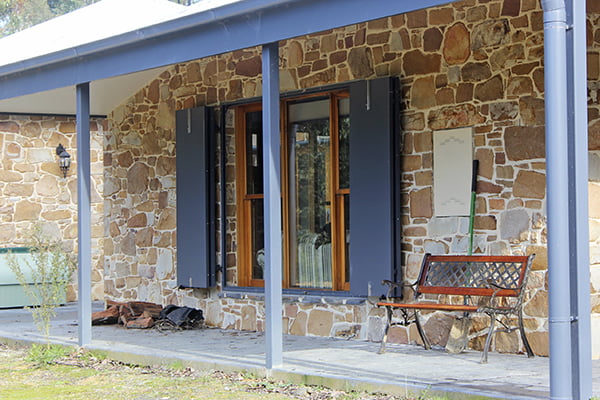
Double duty: Think about whether your shading solution could fulfil another function at the same time—perhaps wind protection, privacy screening, insect screening or protection from ember attack during a bushfire. For example, Sonnenschutz’s range of aluminium external venetian blinds includes a style whose blades can be tilted past horizontal so that the outer edges are raised, allowing daylight to be bounced into the room while providing complete privacy from below.
Colour: Your Home notes that lighter-coloured shading devices reflect more heat, and those with light-coloured undersides make better use of daylight than those with dark-coloured undersides. If you’re looking to retain some of your view through your shading, “fabric colour makes a difference,” says Joe Turner. “The darker the colour, the more heat gets in, but the better the view through the blinds; the lighter colours reflect heat better but don’t give quite as clear a view.”
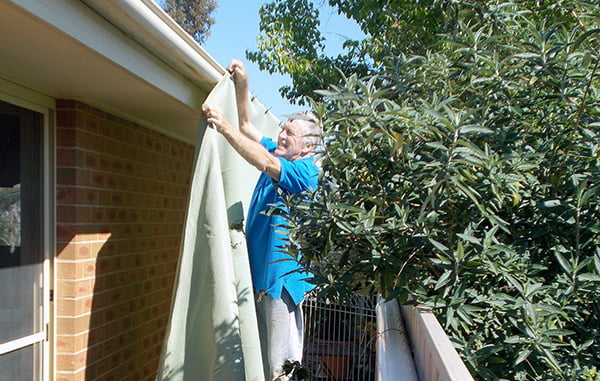
DIY suitability, and ease of removal: If being able to install your shading yourself is important, check that it’s possible for your chosen product. For example, Joe Turner says that while the folding arm awning has “taken the market in Australia by storm”, it consists of two tensioned arms that are attached to the wall with very strong fixings to enable it to extend up to four metres from the wall with no support poles; it definitely needs to be installed by professionals. Other products like roller blinds are easier to DIY.
You might also like to opt for shading that is easy to remove and take with you to your next house, especially if you are a renter. Shadecloth on a freestanding frame or small shade sails are good options here.
At the end of the day
As the climate warms and as cooling becomes a bigger proportion of many homes’ energy load, the importance of well-chosen external shading to keep the heat out before it hits the glass (or walls or roof) is only going to increase. Shaila Divakarla offers this advice for the most sustainable approach to choosing: “Spend time planning before making the choice; give it some thought with respect to your own particular situation. Don’t be swayed by fashion or what your neighbours are doing. Don’t just go for what’s cheapest or looks nice—think about the long-term cost.”
Table of suppliers
We’ve compiled a list of shading suppliers to help guide your choice. Check it out online.
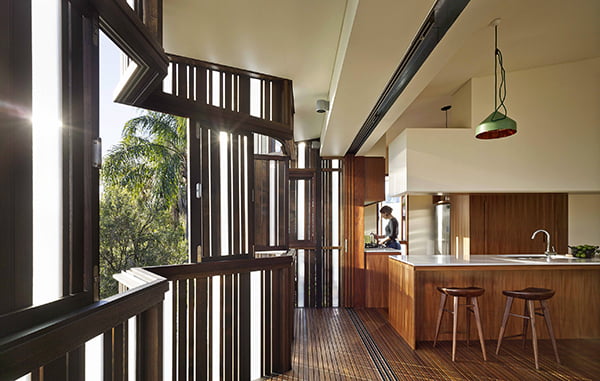
WincovER energy rating scheme
We have ratings schemes for many parts of a building, including the entire building itself with the Home Energy Rating Scheme, so why not a ratings system for shading options?
Well, the Blind Manufacturers’ Association of Australia has been working on just such a rating scheme for window coverings and sun control systems, developed for the BMAA by the technical experts behind the Window Energy Rating Scheme (WERS) together with consulting scientist Dr Peter Lyons.
The new WincovER scheme will provide a simple star rating for many different types of internal and external shading products, with each product being rated separately for both heating and cooling performance out of a maximum possible 10 stars (in half star increments).
To become star rated, materials are tested for their basic solar-optical properties. This data is then used by WincovER to simulate a complete window/shade system, using the data for the material in its most commonly used format on a standard, basic window unit. The simulation provides both the U-value (the level of heat transfer through the material) as well as the solar heat gain coefficient (how readily radiant heat from sunlight passes through a window covering or sun shade system).
Those figures are then used to simulate a whole-of-house scenario to produce energy values for heating and cooling effect, which are then run through the WincovER star rating algorithm to obtain the number of stars for each product.
Rated products will be listed in a publicly accessible database so that homeowners can compare products on a simple star rating basis. At present, there are many different types of internal blind types that can be rated, while exterior products are limited to those that sit parallel to the window. It is expected the range will be broadened in the future as simulation technology allows.
Note that the star rating for the proposed shading system is independent from the WERS (Window Energy Rating Scheme) rating, which rates the energy impact of the selected window system (not the external shading) on the whole house. However, ultimately a WincovER module will be added to WERS which will allow calculation of the effect of adding a shading layer to a window, quantifying the composite performance, whether the shading system is external, internal, or even between two panes of glass.
WincovER is set to be launched in the second half of 2017. For updates, keep an eye on the BMAA website.
Case study: Shaila’s pergola

photo: Shaila Divakarla
Shaila Divakarla was looking to install a pergola to shade her verandah and north-west-facing windows in Cheltenham, Sydney. “We wanted to enjoy the outdoors protected from rain and sun, but at the same time not diminish light into the kitchen and family room, as there is lot of tree cover around and a double-storey house to our north,” she explains.
“Translucent perspex sheet was an affordable option, but I looked for a material that had better thermal properties, looked more aesthetically pleasing and was also stronger. I chose Danpalon, a polycarbonate sheet with a honeycomb structure in the sheet, good thermal properties and the strength to withstand hail. The best part is that the construction system is ‘nail-less’ as the panels just click into connectors, which means that leaks are unlikely and also that the panels can be deconstructed and reused later if required.”
Danpalon comes in varying thicknesses and tints to suit various applications; Shaila chose the very light grey to admit maximum light. She also opted for a pergola construction company that knew Danpalon, could source it and understood its construction method.
“The pergola was almost 1.5 times more expensive than normal perspex sheet would have been, but I think we have more than made up for it with a really ‘cool’ verandah (pun intended!),” says Shaila. “As for running costs, we seldom need air conditioning in our living room and also have rarely used our clothes dryer since installing the pergola, so we have already got our payback on it.”
Case study: DIY awning
Jenny Backholer and Ed Smart describe their courtyard awning solution.
Our inner Melbourne house, built in 2010, is designed around a central courtyard—around 4 x 7 m—which brings the north sun into the living area, located on the south side of the house. With windows on three sides, the courtyard also provides cross-ventilation in summer. It has a Japanese garden theme with a pond, pebbles and lush foliage designed to create a cool feel when viewed from the house.
Although the north-facing windows are shaded from the summer sun by eaves, we found the courtyard was holding the summer heat, causing some of the plants to wilt—just like the human occupants.
While looking for a solution, we discovered sliding horizontal awning blinds (like Roman blinds) made from a polyester PVC-coated mesh. The blinds are supported by horizontal wires and are extended manually using a simple hook on a stick. We installed two 2.4 x 3 m blinds; each has a series of thin, lightweight rods, spaced about 300mm apart, with three metal eyelets. The wires thread through the eyelets to support the rods.

photo: Jenny Backholer and Ed Smart
The standard wires provided with the blinds were too short for our courtyard, but we measured the required length and ordered new ones online from All Things Stainless. This company makes them to size, and fits them with a turnbuckle adjustment which you adjust when you install them.
We have been really happy with the blinds. They create an instant shaded courtyard on hot days, which can be easily converted back to an open sunny courtyard on cooler days. The two blinds cover about half of the courtyard, without restricting the tall bamboo and wisteria which are growing on the perimeter. When not required, the blinds can be pushed back under the eaves and out of the way. If it rains while the blinds are extended, the open weave fabric lets most of the rain through. We’ve found the 2.4 x 3 m size to be quite manageable, including when wet, but larger sizes could be more challenging.
The blinds were available from the wholesaler by special order at Bunnings, but unfortunately the product has now been discontinued. This is a pity as it’s such a simple and effective design. It may be possible to find similar blinds elsewhere; alternatively, a creative Renew reader or a shadecloth supplier could make them to size.
Case study: Beyond House
Tim and Karen’s Melbourne terrace has a narrow north-facing street frontage. To bring natural light in and achieve passive solar performance on the challenging site, architect Ben Callery designed a two-storey extension around a central void. A roof deck sets the extension back from the pitched roof of the retained front part of the house, and a wall of louvre windows and glazed bifold doors admits northern sunlight deep into the home. Ben also opted for a large west window above the void, to provide more natural light to the kitchen and living area, as solar access from the east was blocked by the neighbouring house.

Automated external louvre blinds from Warema protect the extension’s north-facing upstairs glazing from unwanted summer heat gain. Similar blinds are fitted on the high west window (not pictured).
To cope with the unwanted heat load in the hotter months, he specified automated external metal louvre blinds from Warema for both north (pictured) and west windows. “We put big money into them, but without them the west window in particular would be a big problem.”
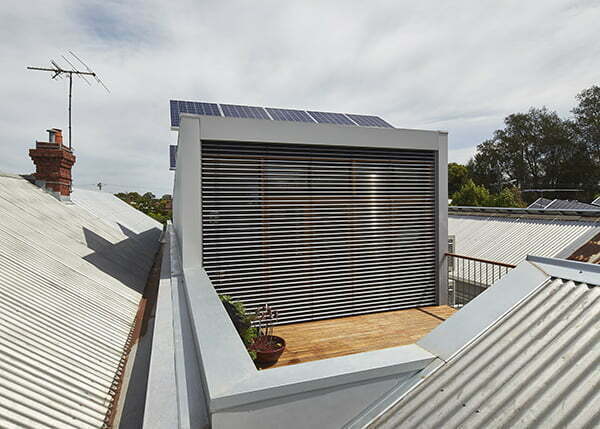
Homeowner Tim says the blinds work well. “Up to about 30 °C it’s fine having the external blinds down and fans going; over 30 °C the blinds start radiating heat in and we need to use the internal blinds too.” He points out that being able to control the blinds remotely via a smartphone app—for example, to regulate temperature before they get home—is very handy.
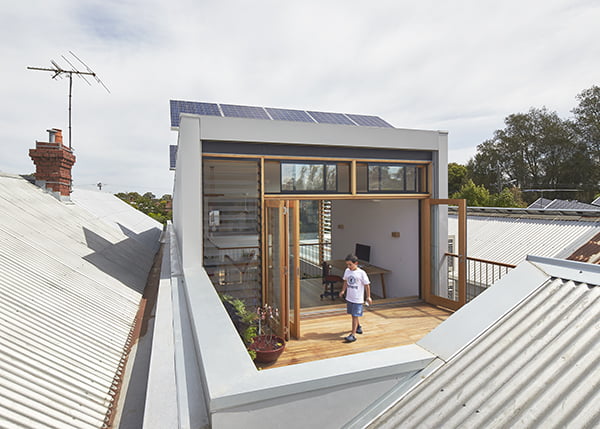
photos: Peter Bennetts
The Beyond House is profiled in Sanctuary 36.
This article was first published in Issue 138 (Jan-Mar 2017) of Renew magazine. Issue 138 has building materials as its focus, including an article on sustainable roofing materials.
Related articles
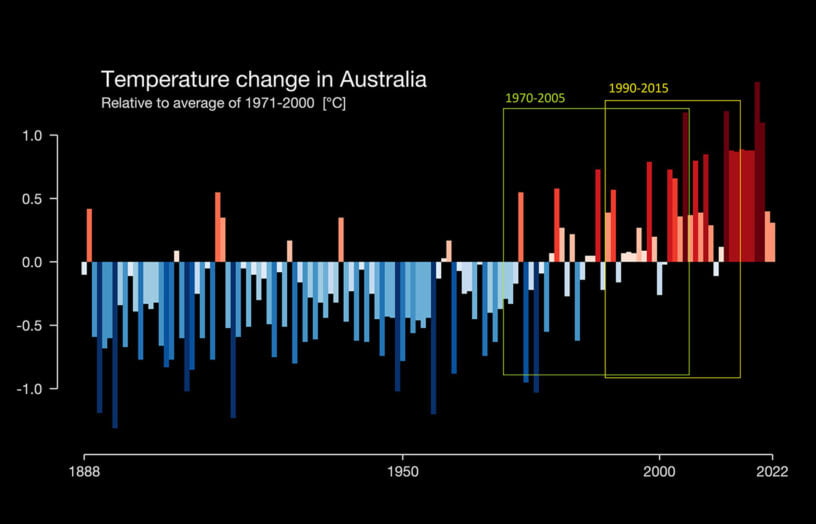 Efficient homes
Efficient homes
Building for a changing climate
Are we building homes for the future, or for the past? Rob McLeod investigates how climate change is impacting home energy ratings and the way we build our homes.
Read more Efficient homes
Efficient homes
Getting off gas FAQs
Do heat pumps work well in Australian conditions? Rachel Goldlust explains.
Read more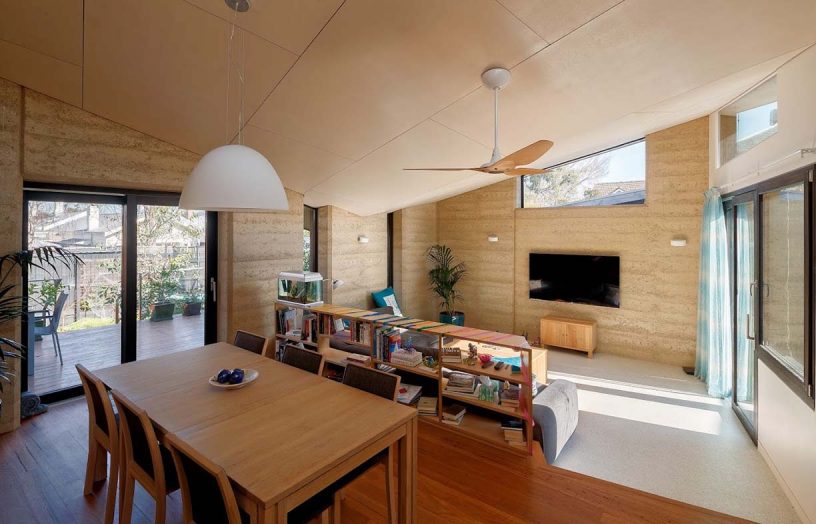 Efficient homes
Efficient homes
Air conditioner vs hydronic heating
Heat pumps can provide air conditioning or hydronic heating. But which is more efficient, and which more comfortable? Cameron Munro tells us what he learned by trying both in his super-insulated home.
Read more
